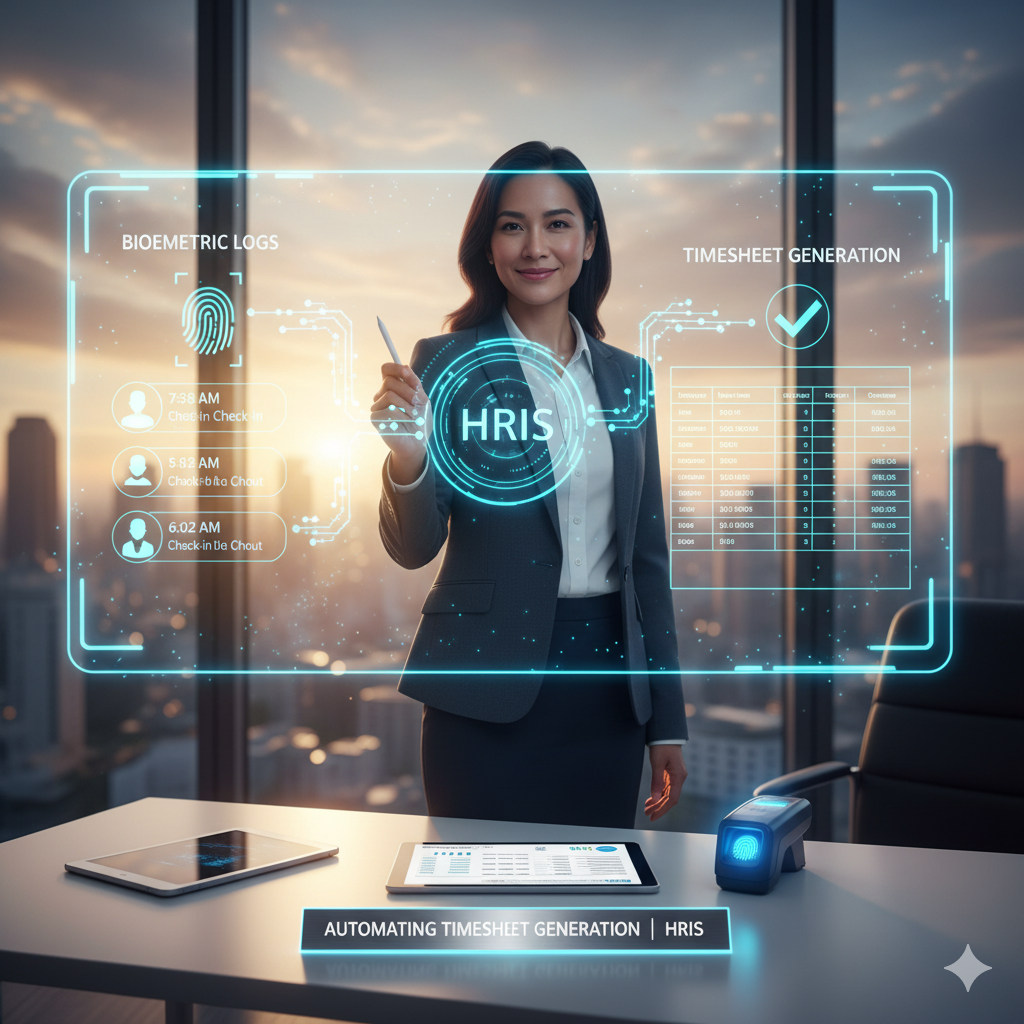Address
Kaypian, San Jose Del Monte City, Bulacan Philippines
Work Hours
Monday to Friday: 8AM - 6PM
Weekend: 10AM - 5PM
Address
Kaypian, San Jose Del Monte City, Bulacan Philippines
Work Hours
Monday to Friday: 8AM - 6PM
Weekend: 10AM - 5PM


Integrated HR. Accurate Payroll.


Integrated HR. Accurate Payroll.

Keeping accurate records of employee attendance is essential for any organization. However, manual timekeeping and timesheet generation can be error-prone, time-consuming, and difficult to manage—especially for growing businesses.
Fortunately, with the integration of biometric devices and a Human Resource Information System (HRIS), companies can now automate timesheet generation with precision and efficiency. This technology eliminates manual data entry, ensures accuracy, and simplifies payroll preparation.
In this article, we’ll explore how HRIS automation turns biometric logs into reliable timesheets, improving both productivity and employee trust.
Biometric logs are digital attendance records captured through biometric devices such as fingerprint scanners, facial recognition systems, or RFID readers. These logs store the exact time employees clock in and out, creating a real-time record of attendance data.
Biometric systems prevent “buddy punching” and ensure accurate attendance tracking — but managing these logs manually still presents challenges. Without automation, HR staff must export, sort, and compute daily logs into timesheets, often leading to inconsistencies or data mismatches.
That’s where HRIS integration comes in.
An HRIS (Human Resource Information System) acts as a central hub that collects, processes, and organizes all HR data—including attendance records. When integrated with biometric devices, HRIS automatically imports log data and generates employee timesheets in real time.
Here’s how the automation works:
| Benefit | Description |
| Accuracy | Biometric data ensures exact in/out times, reducing human error. |
| Efficiency | Saves HR hours by removing manual encoding and computation. |
| Transparency | Employees can verify their attendance and correct errors early. |
| Compliance | Ensures proper labor law adherence for attendance and overtime records. |
| Integration | Automatically syncs data across HR, payroll, and attendance modules. |
Let’s say your company has 200 employees. Without HRIS, your HR staff might spend hours every week consolidating biometric logs into spreadsheets, calculating hours, and identifying errors.
With an HRIS-biometric integration, however:
✅ Logs automatically upload in real time.
✅ The system computes hours worked, absences, and overtime instantly.
✅ Managers can approve or correct timesheets through the HRIS dashboard.
✅ Payroll is processed with accurate, validated data.
What used to take hours or even days can now be done in minutes—error-free.
Automating timesheet generation doesn’t just save time—it transforms HR operations. HR professionals can now focus on strategic tasks like employee engagement, development, and performance management, rather than getting stuck with repetitive administrative work.
Employees, on the other hand, enjoy transparency and trust knowing their attendance and hours are tracked accurately and fairly.
The result?
✅ Faster payroll processing
✅ Reduced attendance disputes
✅ Improved productivity and compliance
By automating timesheet generation from biometric logs, companies can eliminate manual errors, save valuable time, and ensure data accuracy. An HRIS system bridges the gap between attendance tracking and payroll, providing a fully integrated solution that simplifies HR processes and enhances transparency.
In today’s fast-paced workplace, automation isn’t just an advantage—it’s a necessity. If your organization still handles biometric logs manually, now is the time to invest in an HRIS-integrated solution that delivers efficiency, accuracy, and peace of mind for your HR team and employees alike.